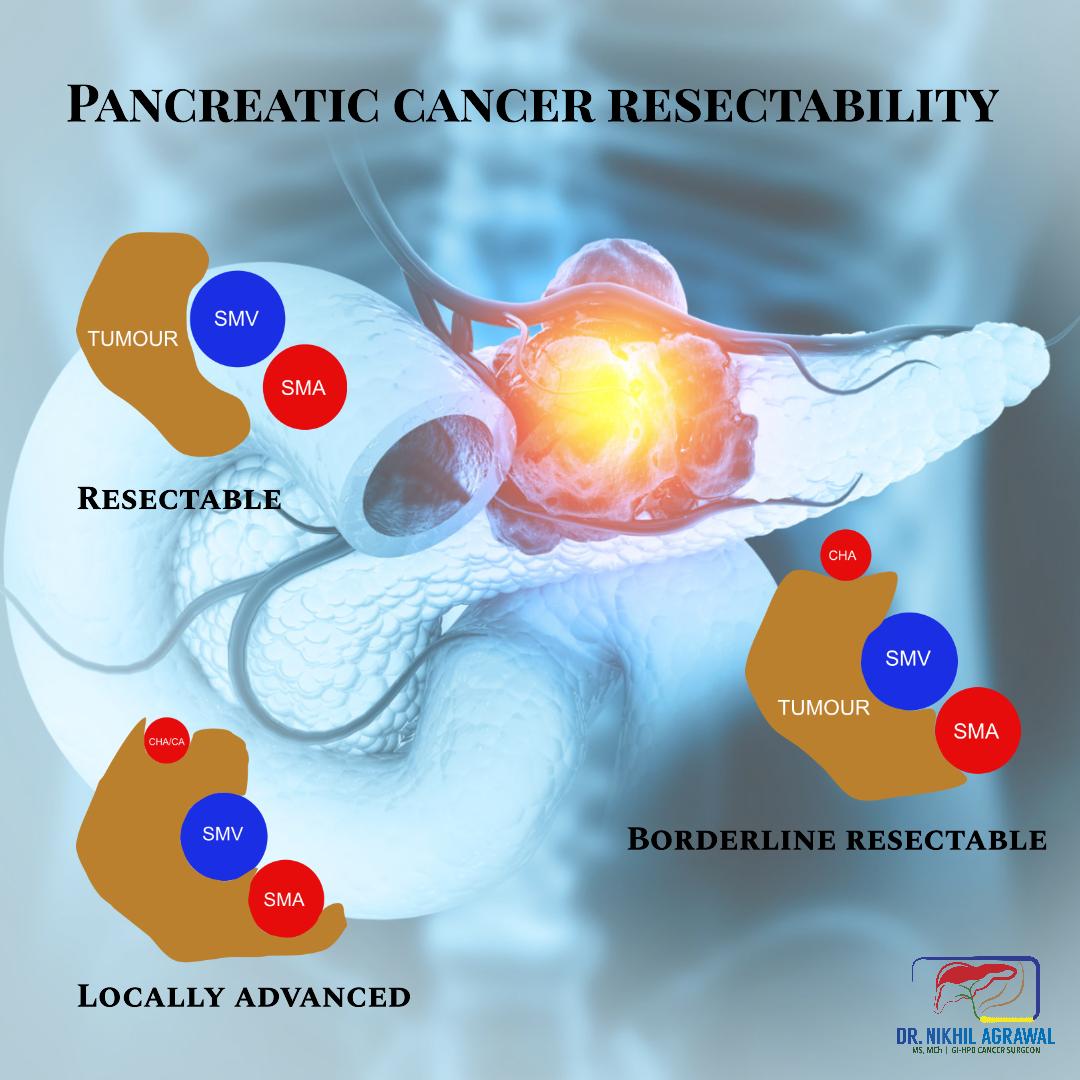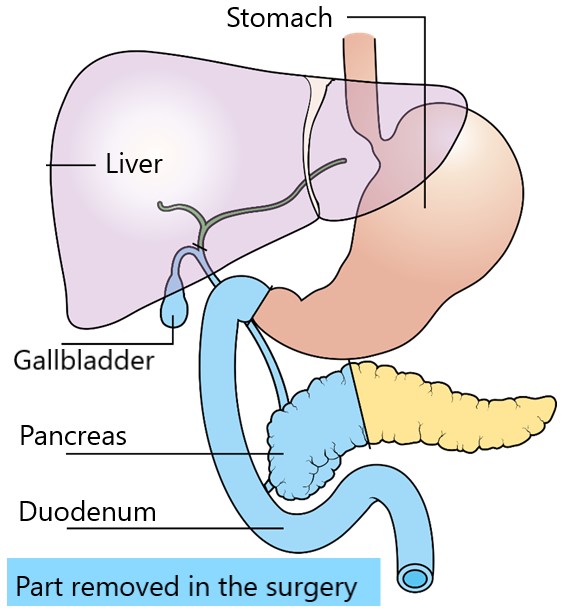PANCREATIC CANCER

Pancreatic cancer is a disease in which cancer cells form in pancreas and then grow.
Pancreas is a flat long organ lying in upper abdomen behind your stomach and in front of vertebral body. It is a soft gland, which is divided into head, body and tail. Many vital structures such as hepatic artery (providing blood supply to liver), superior mesenteric artery (providing blood supply to small intestine), portal vein (drains blood from small intestine and provides blood supply to liver), splenic artery (provides blood supply to spleen) and splenic vein (drains blood from spleen) passes through it or very close to it. It is intricately attached to duodenum, which is a part of intestine. The bile duct also courses through head of pancreas before draining into duodenum. The pancreatic juice also drains into duodenum and thin slender tube carrying it traverses whole of pancreas and is called pancreatic duct.
Pancreas has many important functions. It produces enzymes for digestion (exocrine function) and various hormones (endocrine function). Most of the pancreatic cancer begins in cells of pancreas performing the exocrine function.
Anything that increases your risk of getting a disease is called a risk factor. The risk of someone getting pancreatic cancer increases with age. Some patients get this disease because they are genetically more prone such as in those with a family history or some hereditary conditions such as multiple endocrine neoplasia type 1 (MEN1) syndrome, hereditary nonpolyposis colon cancer (HNPCC; Lynch syndrome), von Hippel-Lindau syndrome, Peutz-Jeghers syndrome, hereditary breast and ovarian cancer syndrome and familial atypical multiple mole melanoma (FAMMM) syndrome. If you smoke then your chances of getting this disease is higher. Another risk factor is chronic pancreatitis.
Risk factors for pancreatic cancer are
- Old age
- Smooking
- Family history or hereditary conditions
- Chronic pancreatitis
- Obesity
Pancreatic cancer is a lethal disease, made more so by the fact that it doesn’t usually cause any symptom till it is advanced. Pancreatic cancer can arise in head of pancreas or body of pancreas. The cancer arising in body of pancreas reveals itself in more advanced stage as it is late to cause any trouble and it is hidden behind other organs. Cancer in the head of pancreas will usually compress the bile duct and cause yellowing of eyes and urine called as jaundice, this is usually accompanied by pale stools and itching. Other warning signs of pancreatic cancer can be weight loss, loss of appetite, abdominal pain and recent onset of diabetes.
Signs and symptoms of pancreatic cancer
- Jaundice (yellowing of skin, eyes and urine with pale stools)
- Abdominal pain
- Weight loss and loss of appetite
- Recent onset diabetes
Diagnosis and staging
Once pancreatic cancer is suspected, it is diagnosed and staged by a high resolution, thin cut, triple phase CT scan. Your surgeon will also do tests to quantify your jaundice, check your kidney function, haemoglobin and blood clotting parameters. A tumor marker called as CA19.9 will also be checked. A chest X-ray or a CT scan of chest will be done to look for any tumor in the chest. Some centres might also do a CT-PET scan.
Based on the result of these tests your disease will be classifies into resectable, borderline resectable, unresectable or metastatic.
Resectable: when the disease is picked up at as stage where it can be clearly removed by surgery.
Borderline resectable:when the disease has grown to a stage where the cancer is infiltrating some vital vessel coursing through or adjacent to pancreas. But it can be removed by surgery, by either cutting or re-joining the involved vessel and/or, decresing the size of tumor by giving chemotherapy or chemoradiotherapy prior to surgery called as neoadjuvant treatment.
Unresectable: when the staging scan shows that disease has reached such a stage where it cannot usually be removed surgically.
Metastatic: when the pancreatic cancer had spread to organs beyond the pancreas. This is advanced stage and curative treatment is not possible.

Biopsy
Biopsy or FNAC is a procedure in which the cancer is sampled to confirm the diagnosis. However, it is not required if the CT scan can diagnose the tumor and it is in the resectable stage. For other stages it is required.
Treatment - Curative
The treatment depends upon the stage of the disease and degree of jaundice. Surgery is the best possible option and can be considered if the cancer is diagnosed at resectable or borderline resectable stage. If the jaundice is very high, your surgeon may choose to decrease the jaundice before surgery by doing a procedure called ERCP and stenting. In this a plastic or metallic tube is placed in the bile duct which is compressed by tumor and opens it up.
If the tumor is advanced (such as in borderline resectable cases) then he may also give you neoadjuvant treatment (chemotherapy or chemoradiotherapy) to decrease the size of tumor and increase your chances of survival.
For unresectable tumors, an attempt to made to downstage them to a stage where they can be surgically removed. For this neoadjuvant treatment is administered and some of these patients will become operable.
Surgery
The surgery for pancreatic cancer depends upon the location of tumor. For cancers of pancreatic head a Whipple operation also known as pancreaticoduodenectomy is done. For cancer of body of pancreas distal pancreatectomy is done.
In pancreaticoduodenectomy, head of pancreas is removed along with duodenum, bile duct, gall bladder, part of stomach, small part of small intestine and adjacent lymph nodes. To restore gastrointestinal continuity, small intestine is then joined to pancreas (sometimes pancreas is joined to stomach), remaining bile duct and stomach.

Whipple Operation or Pancreaticoduodenectomy: The part colored blue is removed in surgery.
Treatment - Palliative
Chemotherapy uses drugs to destroy cancer cells. For metastatic cancers, surgery is not an option. After FNAC/biopsy and stenting (if jaundiced) chemotherapy is given. Chemotherapy prolongs survival.
If the tumor is causing blockage of food passage then a metal stent is placed in the food passage endoscopically. If this fails then a bypass surgery will be required.
Wish you a speedy recovery!


